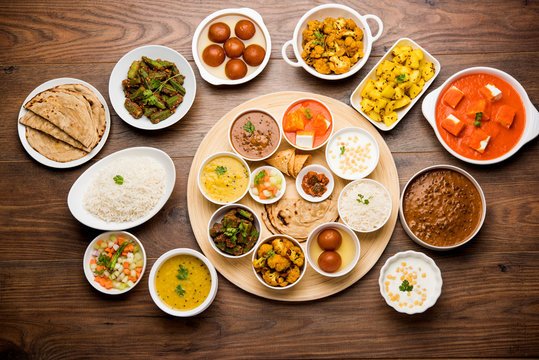A Delicious Dive into North Indian Food (1250 Words)
Food is more than just something we eat to fill our stomachs—it’s a memory, a celebration, a story on a plate. And if there’s any cuisine in the world that captures this idea so beautifully, it’s North Indian food. Whether it’s the creamy curries of Punjab, the spicy chaats of Uttar Pradesh, or the royal richness of Rajasthani thalis, North Indian cuisine is a world of its own.
Let’s take a journey through this flavorful, comforting, and incredibly diverse food culture—one bite at a time.
What Makes North Indian Food So Special?
North India is a huge region, covering states like Punjab, Uttar Pradesh, Delhi, Haryana, Rajasthan, Jammu & Kashmir, Himachal Pradesh, and Uttarakhand. Naturally, the food here is as diverse as its geography—spanning snowy mountains, deserts, and fertile plains.
But despite the differences, there’s a certain warmth that connects all North Indian dishes. The heavy use of spices, the love for dairy, and the passion for cooking every dish with time and care make this cuisine deeply satisfying.
Wheat, Ghee, and Spices – The Basics
One of the biggest differences between North Indian and South Indian food is the staple grain. While the south leans more on rice, North India is all about wheat. You’ll rarely find a North Indian meal without roti, paratha, or naan on the side.
Ghee (clarified butter) is another hero of the kitchen. It’s poured generously over dal, used in frying, and even added to hot rotis. Ghee not only adds flavor—it’s also considered good for health in Ayurveda.
Then there are the spices. Oh, the spices! North Indian kitchens are full of earthy aromas—cumin, coriander, turmeric, garam masala, cinnamon, cloves, and more. The food isn’t always hot-spicy, but it’s always full of depth and flavor.
The Kings of the Plate – Famous Dishes of North India
Now let’s talk about what’s actually on the plate. North Indian cuisine has some absolute stars that you’ve probably heard of—and if not, you’re in for a treat.
1. Dal Makhani
This slow-cooked black lentil dish is creamy, rich, and comforting. It’s cooked with butter and cream and often eaten with naan or jeera rice. It’s one of those dishes where every spoon feels like a warm hug.
2. Butter Chicken
Born in Delhi, butter chicken is now world-famous. It’s tender chicken cooked in a buttery tomato-based gravy, usually served with naan. Slightly tangy, a little sweet, and completely indulgent.
3. Rajma Chawal
Simple, soulful, and homely. This kidney bean curry served with rice is a staple in Punjabi homes. It’s not fancy, but it’s one of the most loved comfort foods in the region.
4. Chole Bhature
Fluffy fried bread (bhature) served with spicy chickpeas (chole). This dish is a street food icon, especially in Delhi and Punjab. It’s heavy but unforgettable.
5. Rogan Josh
From the chilly valleys of Kashmir, this mutton curry is rich and full of spices. The meat is cooked until tender in a thick, flavorful gravy. It’s perfect for cold winter evenings.
6. Rajasthani Dal Baati Churma
This traditional Rajasthani dish is a full meal—crispy baked balls of wheat (baati), served with spicy dal and sweet churma. It’s earthy, filling, and full of rustic charm.
Vegetarian Heaven
North Indian cuisine is incredibly vegetarian-friendly. Many regions, especially in Uttar Pradesh and Rajasthan, have a huge variety of pure veg dishes, all bursting with flavor. A few highlights:
- Aloo Gobhi – Potatoes and cauliflower cooked with spices.
- Baingan Bharta – Smoky mashed eggplant with onions, tomatoes, and spices.
- Palak Paneer – Spinach and cottage cheese in a creamy curry.
- Shahi Paneer – A royal dish with paneer in a rich, nutty tomato gravy.
Don’t Forget the Breads!
In North India, bread isn’t just a side—it’s a star. And the variety is mind-blowing.
- Roti/Chapati – The daily flatbread, healthy and light.
- Paratha – Stuffed with everything from potatoes to paneer to lentils. Perfect for breakfast with curd and pickle.
- Naan – Soft, slightly chewy, and often served in restaurants.
- Kulcha – Popular in Amritsar, this is a flaky, soft bread usually served with chole.
- Poori – Deep-fried puffy bread, often eaten during festivals or special occasions.
Street Food You Can’t Miss
You can’t talk about North Indian food without mentioning its incredible street food. The streets of Delhi, Lucknow, Varanasi, and Jaipur are filled with snacks that are spicy, tangy, crunchy, and addictive.
- Golgappe/Pani Puri – Crispy balls filled with spicy water and potato.
- Aloo Tikki – Crispy mashed potato patties served with chutneys.
- Dahi Bhalla – Soft lentil dumplings in creamy yogurt, topped with tamarind and mint chutneys.
- Pav Bhaji – Spicy mashed vegetables served with buttered buns.
- Kachori – Deep-fried flaky bread stuffed with lentils or onions.
The Sweet Side of Life
North Indian sweets are pure joy. Most are made with milk, khoya, ghee, and sugar—and almost all are made during festivals, weddings, or any celebration.
- Gulab Jamun – Deep-fried dough balls soaked in sugar syrup.
- Jalebi – Crispy spirals dipped in hot sugar syrup, often eaten hot.
- Rasgulla and Rasmalai – Soft cheese balls soaked in syrup or creamy milk.
- Gajar ka Halwa – Carrot pudding slow-cooked with milk and ghee.
- Ladoo, Barfi, Peda – The variety is endless and every region has its own version.
Drinks That Refresh and Nourish
Along with food, North Indians love their traditional drinks.
- Lassi – A thick yogurt-based drink, sweet or salty. Punjab’s favourite!
- Chai – Masala chai (spiced tea) is practically a religion here.
- Kesar Badam Doodh – Warm milk flavored with saffron and almonds.
- Kanji – A fermented drink made from black carrots, popular in winters.
- Thandai – A festive drink made with milk, nuts, and spices, often during Holi.
Food for the Soul – Festivals and Traditions
In North India, food is deeply tied to culture and religion. Every festival comes with its own special dish:
- Diwali brings sweets like laddoos, barfis, and chaklis.
- Holi means gujiya, thandai, and dahi bhalla.
- Eid is incomplete without biryani and sheer kurma.
- Navratri comes with vrat food—sabudana, kuttu atta, and aloo dishes.
Even weddings are lavish affairs with endless courses—from snacks to desserts, no one goes home hungry.
A Living Culinary Heritage
North Indian food has been influenced by many cultures—Mughal emperors, Persian traders, British colonials, and local kings have all left their marks. That’s why you’ll find dishes rich in dry fruits, slow-cooked meat, and aromatic spices alongside humble home-cooked dals and sabzis.
What makes this cuisine truly special is the balance between tradition and innovation. Families still follow old recipes passed down through generations. At the same time, young chefs in cities like Delhi and Lucknow are giving modern twists to classic dishes.
In Conclusion – A Feast for the Senses
North Indian food is more than a cuisine—it’s an experience. It’s the sizzle of onions hitting hot ghee. The comfort of a bowl of dal chawal. The joy of sharing parathas on a cold morning. It’s spicy, creamy, tangy, sweet, and sometimes all of that in one bite.
Whether you’re enjoying a royal Rajasthani thali, a plate of butter chicken, or a simple meal of roti and sabzi at home, North Indian food always feels like a celebration of life.
So the next time you sit down to eat a North Indian meal, take a moment to taste the story, the culture, and the love cooked into every dish.

